tow BUICK SKYLARK 1993 Owners Manual
[x] Cancel search | Manufacturer: BUICK, Model Year: 1993, Model line: SKYLARK, Model: BUICK SKYLARK 1993Pages: 306, PDF Size: 15.84 MB
Page 20 of 306

Front Seatback Latches (Two-Door Models)
The front seatback folds forward to let people get into
the back seat.
Your seatback will move back and forth freely, unless
you come to a sudden stop. Then it will lock in place.
There's one time
the seatback may not fold without
some help
from you. That's if your vehicle is parked
going down a fairly steep hill. To
fold
a front seatback
forward,
push the
seatl&k
j' , toward the
re& '&$.: you lit .this :
latch. Then the
,seatbak will
fold
forward. The latch
must be down for the
seat
to work. .properly.
19
Page 59 of 306
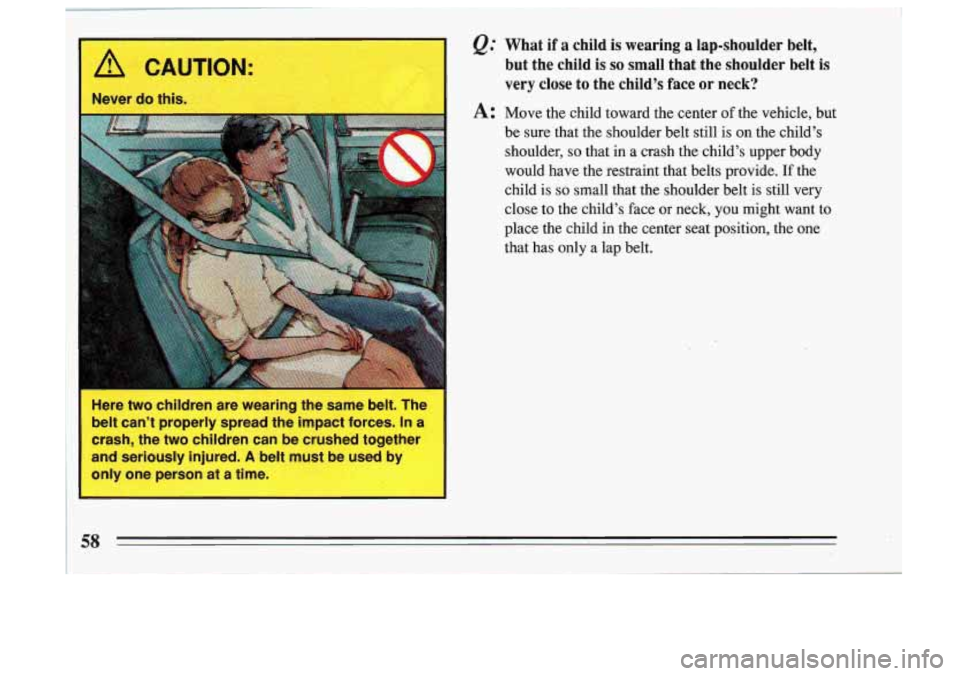
f&’ What if a child is wearing a lap-shoulder belt,
but the child
is so small that the shoulder belt is
very close to the child’s face OF neck?
A: Move the child toward the center of the vehicle, but
be sure that the shoulder belt still is on the child’s
shoulder,
so that in a crash the child’s upper body
would have the restraint that belts provide.
If the
child is
so small that the shoulder belt is still very
close to the child’s face or neck, you might want to
place the child
in the center seat position, the one
that has only a lap belt.
Page 73 of 306

Ignition Key Positions
Your square-headed key
opgs.@gs ,. .r , your ignition lock. ..
This lock gives you five different positions.
Before you put the key in, your ignition will be in the
Lock position. This position locks your ignition, steering
wheel and transaxle. It’s a theft deterrent feature.
The other positions let you perform these functions:
ACC: Accessory lets you’use things like the radio and
the windshield wipers when the engine is
off. To use
“Acc,” push in the key and turn
it toward you. Your
72
Page 75 of 306

1 To start your L4 2.3 Lites (Code 3) engine:
I
Don’t push the accelerator pedal before starting your
engine. In some other vehicles you might need to do
this, but because of your vehicle’s computer systems,
you don’t.
Turn your ignition key to “Start.” When the engine
starts, let go of the key. The idle speed will go down
as your engine gets warm.
If it doesn’t start right away, and the weather is very
cold (below
-20’ .F, or -29’ C), push the accelerator
pedal about one-quarter of the way down while you
turn the key to
“Start.” Do this until the engine starts.
As soon as it does, let go of’the key.
4. If your engine still won’t start (or starts but then
stops), it could
be flooded with too much gasoline.
Try pushing your accelerator pedal all the way to the
floor and holding it there as you hold the key in
“Start” for about three seconds. This clears the extra
gasoline from the engine.
If the car starts briefly but
then stops again, do the same thing, but this time
keep the pedal about one-quarter of the way down
for five or six seconds.
electronics in your vehicle. If you add electrical
electrical equipment, check
you don’t, your engine rnigh
the part
of this Manual that tells how to do it
without damaging your vehicle. See “Towin
Your Car” in the Index.
74
Page 78 of 306
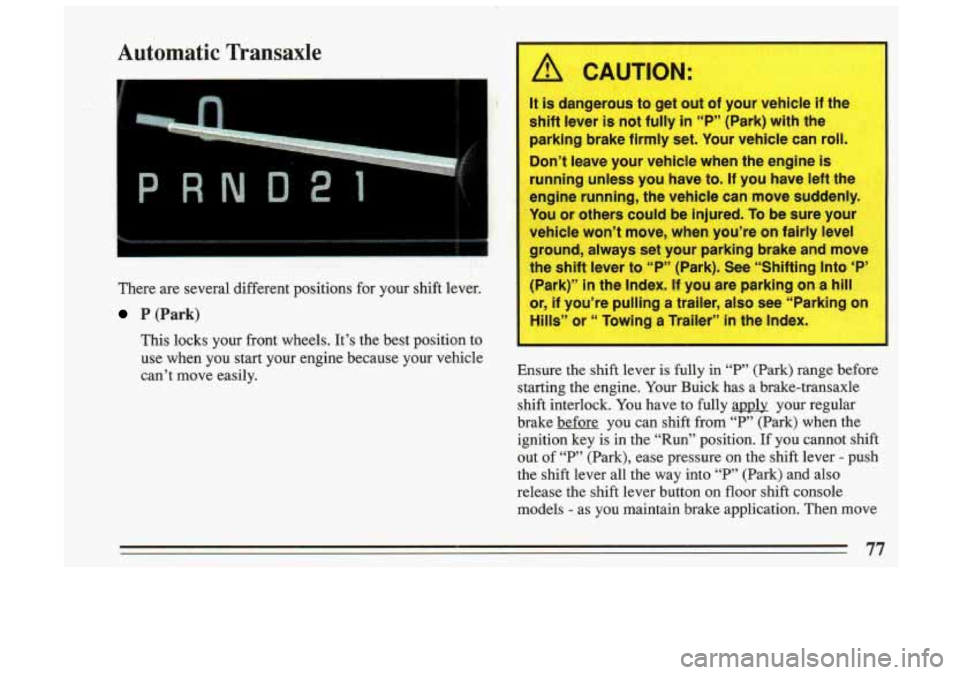
Automatic Transaxle
There are several different positions for your shift lever.
P.(Park)
This locks your front wheels. It’s the best position to
use when you start your engine because your vehicle
can’t move easily.
A CAUTION:
It is dangerous to get out of your vehicle if the
shift lever
is not fully in “P” (Park) with the
parking brake firmly set. Your vehicle can
roll.
Don’t leave your vehicle when the engine is
running unless you have to. If you have left the
engine running, the vehicle can move suddenly.
You or others could be injured.
To be sure your
ehicle won’t move, when you’re on fairly level
ound, always set your parking brake and move
e shift lever to
“P” (Park). See “Shifting Into ‘P’
ark)”
in the Index. If you are parking on a hill
, if you’re pulling a trailer, also see “Parking on
11s” or “ Towing a Trailer” in the Index.
Ensure the shift lever is fully in “P” (Park) range before
starting the engine. Your Buick has a brake-transaxle
shift interlock. You have to fully apply your regular
brake before you can shift from “P” (Park) when the
ignition key is in the “Run” position.
If you cannot shift
out of
“P” (Park), ease pressure on the shift lever - push
the shift lever all the way into
“P,’ (Park) and also
release the shift lever button on floor shift console
models
- as you maintain brake application. Then move
77
Page 79 of 306

1 the shift lever into the gear you wish. (Press the shift
lever
button before moving the shift lever on floor shift
3: console models.) See “SI
section,
R (Reverse)
Use this gear to back ifting’ Out
of ‘I?’ (Park)” in this
To rock your vehicle back and forth
to get out of snow,
ice
or sand without damaging your transaxle, see “If
You’re Stuck: In Sand, Mud, Ice or, Snow” in the Index.
N (Neutral)
In this position, your engine doesn’t connect with the
wheels. To restart when you’re already moving,
use
“N” (Neutral) only. Also, use “N’ when your vehicle
is being towed.
I
A CAUTION:
hifting out of ‘‘P” (Park) or “N” (Neutral) while
our engine is “racing” (running at high speed)
s dangerous. Unless your foot is firmly on the
rake pedal, your vehicle could move very
apidly. You could lose control and
hit people or
bjects. Don’t shift out of
“P” (Park) or “N”
[Neutral) while your engine is racing.
Damage to your transaxle caused by shifting out
I
of “P” (Park) or “N” (Neutral) with the engine
racing isn’t covered by your warranty.
I
D (Drive)
This position is for normal driving.
Page 82 of 306
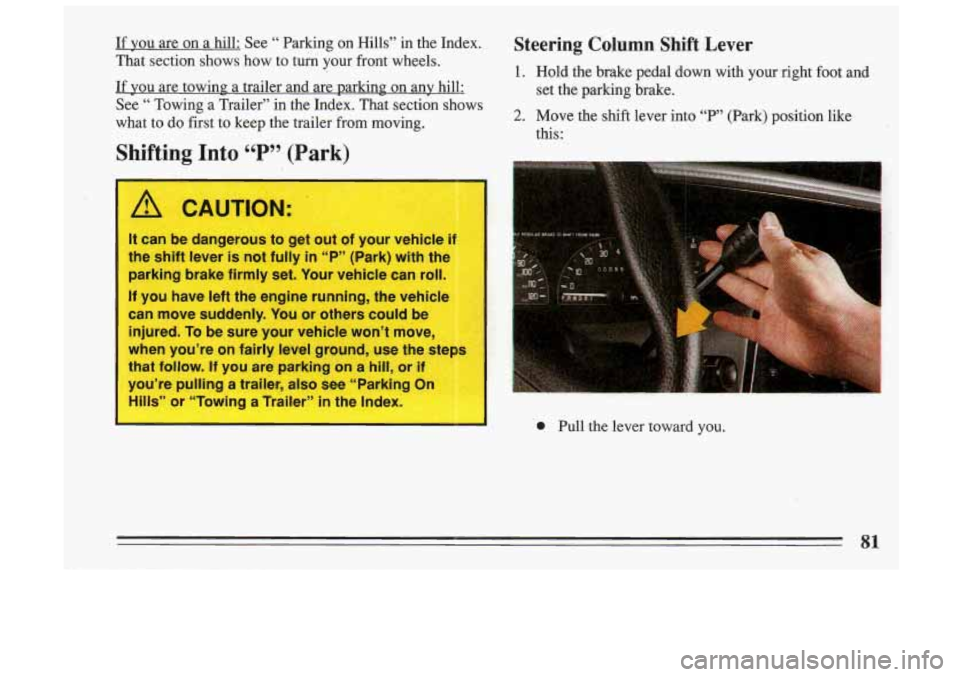
If YOU are on a hill: See “ Parking on Hills” in the Index.
That section shows how to tuk your front wheels.
If you are towing a trailer and are parking on any hill:
See
“ Towing a Trailer” in the Index. That section shows
what to do first to keep the trailer from moving.
Shifting Into 44 P 99 (Park)
I I
A CAUTION:
It can be dangerous to get out of your vehicle if
the shift lever is not fully in “PYy (Park) with the
parking brake firmly set. Your vehicle can roll.
If you have left the engine running, the vehicle
can move suddenly. You or others could be
injured. To be sure your vehicle won’t move,
when you’re on fairly level ground, use the steps
that follow.
If you are parking on a hill, or if
you’re pulling a trailer, also see “Parking On
Hills” or “Towing a Trailer”
in the Index.
Steering Column Shift Lever
1. Hold the brake pedal down with your right fuot and
2. Move the shift lever into “F”’ (Park) position like
set
the parking brake.
this:
0 Pull the lever toward you.
81
Page 83 of 306
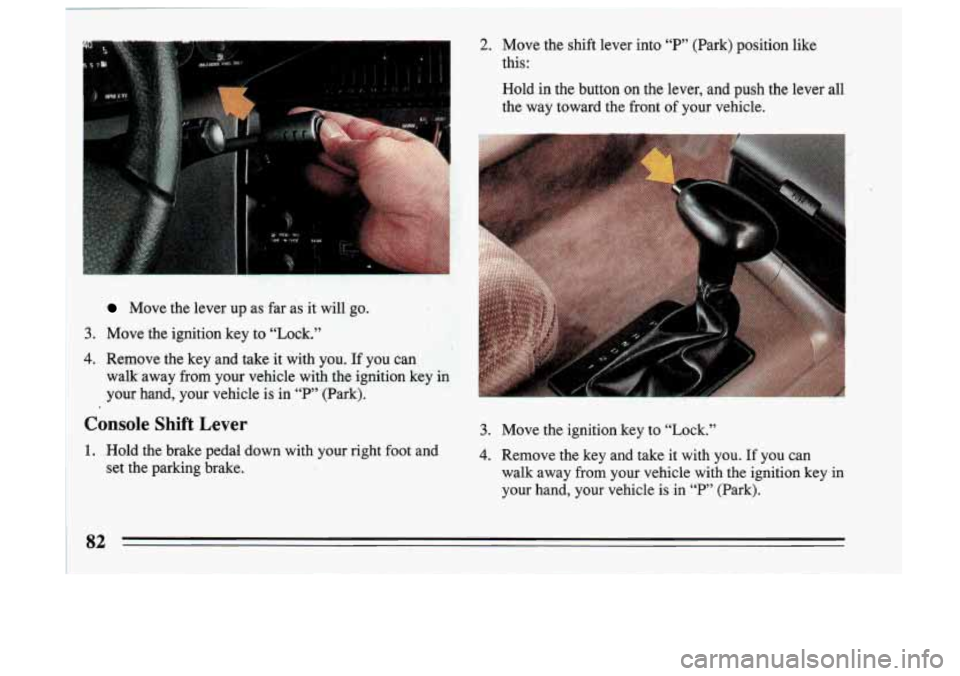
2. Move the shift lever into “P” (Park) position like
this:
Move the lever up as far is it will go.
3. Move the ignition key to “Lock.”
4. Remove the key and take it with you. If you can
walk away
from your vehicle with the ignition key-in
your hand, your vehicle is-in
‘‘P13 (Park).
Console Shift Lever
1. Hold the brake ped4 down with your right foot and
set the parking brake.
Hold in the button on the lever, and push the lever all
the way toward the front of your vehicle.
3. Move the ignition key to “Lock.”
4. Remove the key and take it with you. If you can
walk away from your vehicle with the ignition key in
your hand, your vehicle is in
“P” (Park).
82
Page 84 of 306
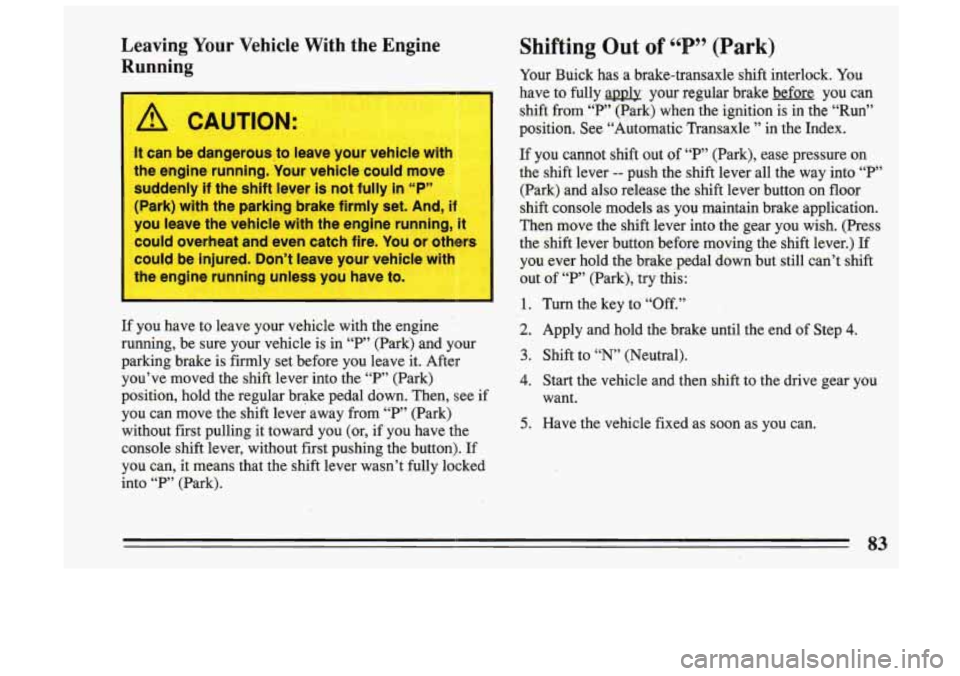
Leaving Your Vehicle With the Engine
Running
CAUTION:
It can be dangerous,to leave your vehicle with
the engine running. Your vehicle could move
suddenly
if the shift lever is not fully in “P”
(Park) with the parking brake firmly set. And,
il
you leave the vehicle with the engine running, it
could overheat and even catch fire. You or others
I
could be injured. Don’t leave your vehic ’ wi
the engine running unless you have to.
I
If you have to leave your vehicle with the engine
running, be sure your vehicle is in
“P” (Park) and your
parking brake is firmly set before you leave it. After
you’ve moved the shift lever into the
“P” (Park)
position, hold the regular brake pedal down. Then, see if
you can move the shift lever away from “P” (Park)
without first pulling it toward you (or, if you have the
console shift lever, without first pushing the button). If
you can, it means that the shift lever wasn’t fully locked
into
“P” (Park).
Shifting Out of P (Park) 66 99
Your Buick has a brake-transaxle shift interlock. You
have to fully applv your regular brake before
you can
shift
from “P” (Park) when the ignition is in the “Run”
position. See “Automatic Transaxle ” in the Index.
If you cannot shift out of “P” (Park), ease pressure on
the shift lever -- push the shift lever all^ the way into “P”
(Park) and also release the shift lever button on floor
shift console models as you maintain brake application.
Then move the shift lever into the gear you wish. (Press
the shift lever button before moving the
shift lever.) If
you ever hold the brake pedal down but still can’t shift
out of “P” (Park), try this:
1. Turn the key to “Off.”
2. Apply and hold the brake until the end of Step 4.
3. Shift to “N’ (Neutral).
4. Start the vehicle and then shift to the drive gear you
5. Have the vehicle fixed as soon as you can. want.
Page 86 of 306
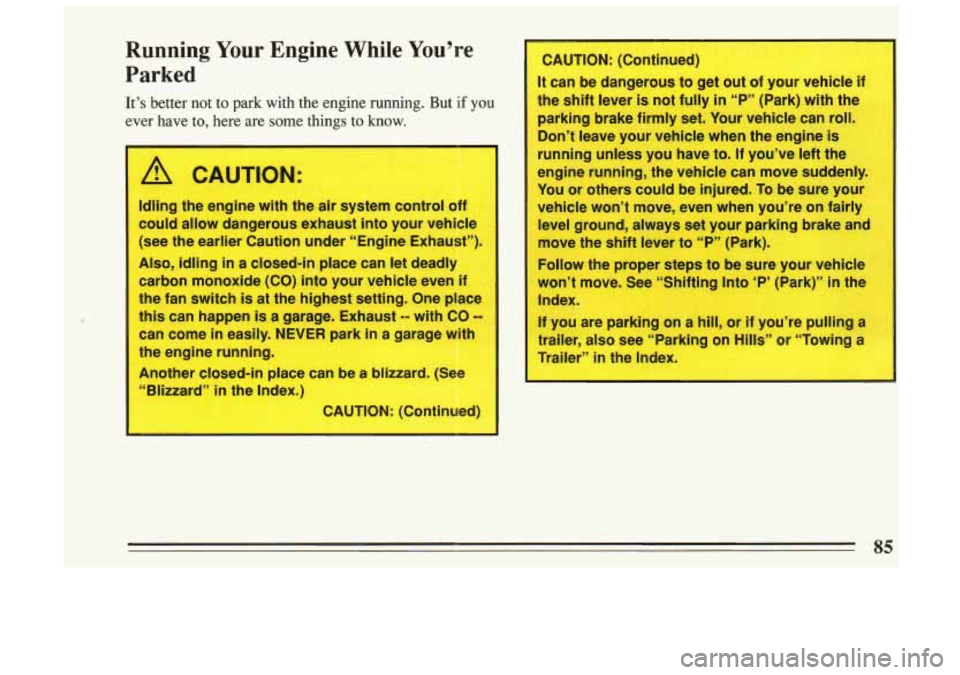
P
-Running Your Engine While You’re
‘Parked
It’s better n.ot to park with the engine running. But if YOU
ever have to, here are~same things to how.
Idling the engine with tfie air 31 em control off
8could al~low dangerous exhaust into jour vehilcle
(see the earlier Cawtionunder “‘Engine IExhaust”:
Also, idling In a Closed-in> place can let‘ ‘dead.,
‘carbon monoxide
(CO) into yo~ur ve,hicle ewn if
t’he fan switch
is at the highest setting. One placl
this can happen is agarage. Exhaust -- with CO
can came in easily. #NEVER park in a garage with
the engine running.
Another clq3ed8-in;
place can be a blizzard. l(See
in the Index.)
nued:
It can ‘be dangerous ta get ‘olut lof ,your vehicle if
‘the shift lever is not fully
in T’ (Park) witlh trhe
parking brake flirmly set. Your vehicle
can roll.
Dm’t leave yaur vehic;le when the engine
is
running unless you have to. If you’ve lefi the
enlgine running, the vehicle can
move suddenly.
You
or others cou!ld be injured. To be sure yow’r
vehicle wonlpt move, even when
you’re on fair ~
level gramd, always set your parking brake and’
move
the shift lever to “P” (Park).
Follow the prope!r steps
to be sure your vehicle
wm’t move. See “S’hifting
Into ‘PB (Park)”’ in the
Inde?.
If
you are parking on a hill, or if you’lre pulling a
trailer,
atso see “Parking OM Hills”’ or “Towing, a
‘Trailer”
in th’e Index.
85